Ultherapy & Skin Tightening Treatments NYC
Youthful skin is naturally elastic, firm, and supple, and often taken for granted! As we age, skin elasticity and firmness begins to decline, resulting in loose, sagging skin and the appearance of fine lines and wrinkles. These age-related skin concerns are often most noticeable on the face and neck, though other areas of the body can be affected, too. Although fine lines, wrinkles, and skin laxity are often a part of the natural aging process, there are cosmetic treatment options available that can reduce their visibility while allowing us to age gracefully. Thanks to the technological advancements that have been made in the field of cosmetic dermatology, there is now an abundance of non-invasive cosmetic treatment options that are able to help prevent and reverse the signs of aging to reveal a more youthful appearance.
As we pass our mid-twenties, collagen production in the body begins to reduce. This process continues to decrease into our thirties and beyond. Collagen is the elastic substance that brings the firmness and elastic nature to our skin. With less collagen our skin starts to sag and become more wrinkled. This is especially true in areas that move a lot, such as the forehead and the area around the lips. When it comes to sagging skin, you’ll find that the cheeks and the neck tend to be areas where this is more likely to occur. Unfortunately, traditional skin care routines are unable to prevent skin laxity.
However, with modern technological advancements in the world of dermatology, patients no longer need to resort to cosmetic surgery, a surgical facelift, or invasive medical procedures to improve their appearance. Today, there are a number of non-invasive treatments that can be used to help with collagen production and make the body produce new collagen that can tighten the skin and reduce fine lines and wrinkles. Dr. Michele Green is a leader in cosmetic dermatology and non-invasive cosmetic procedures such as Botox®, Juvederm® injections, Fraxel®, non-surgical facelifts and skin tightening lasers. Dr. Green has the most cutting edge technology in her private boutique NYC dermatology office. Dr. Green will help create the ideal skincare protocol for you and achieve the best non-invasive skin tightening results in New York City.

What is Ultherapy?
Ultherapy® is an FDA-cleared procedure that uses ultrasound energy. It is possible to use Ultherapy for the brow, chin, neck and the upper chest (also known as the décolletage). The way Ultherapy works is that it uses focused ultrasound which in turn stimulates new collagen formation under the surface of the skin. This means that dermatologists can see the tissue within the skin layers as they are carrying out the treatment. During the procedure, the applicator can therefore be targeted to the precise location where it will have maximum benefit to the loose skin.
Ultherapy treatment is slightly different from other skin tightening treatments, such as the highly popular Thermage skin tightening experience, as it uses ultrasound technology to boost collagen production in the body. It was initially developed by the company Ulthera, and the Ultherapy device is able to target the deeper layers of tissue that were previously only addressed via plastic surgery. The ultrasound technology behind Ultherapy provides the doctor with a visualization of targeted tissue during the treatment. At the start of treatment, ultrasound gel is applied to the surface of the skin, and then the doctor determines the appropriate treatment area and delivers ultrasound energy to the dermis.
How does Ultherapy work?
Ultherapy is an ultrasound treatment for skin tightening that uses ultrasound imaging to determine the treatment area in which the absence or deterioration of collagen is most pronounced for a targeted treatment. Ultherapy is a non-invasive procedure for tightening the skin and providing a youthful “lift” to the treatment area. As we age, the body begins to produce less collagen and elastin, which are two proteins that give the skin a smooth, firm, and youthful appearance. When collagen and elastin production decrease, the skin begins to lose elasticity, which leads to loose and sagging skin. This is particularly apparent on the face and neck and may be characterized by the development of jowls or turkey neck. With Ultherapy, these signs of aging can be reduced.
The treatment works by releasing a targeted beam of heat energy into the deep layers of the dermis. The beam of energy heats the tissue beneath the surface of the skin, which triggers the body’s natural healing process. Within this natural healing process, the body produces more collagen and elastin, which serves to provide the skin with a lifted, youthful look. For that reason, the effects of the treatment improve gradually over time, usually between 60 and 90 days, because of the natural healing process that is occurring in the treated area. Ultherapy is a non-invasive procedure meaning that while the applicator releases a pulse of energy, the outer layer of the skin remains unaffected and unharmed.
Does Ultherapy Work?
When it comes to nonsurgical skin tightening treatment, patients want to be sure that their treatment will be effective. The ultrasound technology of Ultherapy does offer useful results for a variety of patients, particularly when it comes to reducing loose skin in the brow area, along the jawline and neck, and the décolletage. However, as a disclaimer, it’s important to note that many patients find Ultherapy to be uncomfortable, and it does not always yield the best cosmetic treatment results when it comes to improving the appearance of loose skin. However, it can be an effective option for patients who have mild to moderate skin laxity.
Clinical trials have been done to measure the success of the treatment and have found that a majority of patients see an improvement and are either satisfied with the results of very satisfied. Specifically, 65% of the patients who received Ultherapy treatment said that there was an improvement to their skin between 60 and 180 days after receiving the treatment. Similarly, 67% of patients reported that they were either satisfied or very satisfied with the effects of the treatment after 90 days.
What is the Ultherapy treatment procedure?
If you are looking to tighten the skin on your neck, jowls, and face, and eliminate fine lines and wrinkles, for an overall reduction in the signs of the natural aging process, the first course of action is to schedule a consultation with Dr. Michele Green in New York. When you arrive for your initial consultation, Dr. Green will examine the treatment area and make a determination about the best cosmetic plan that will best address your unique aesthetic goals and needs. Whether it be Botox injections, dermal fillers like Juvederm or Restylane®, Fraxel laser, Microneedling, Thermage®, or Ultherapy, Dr. Green will help guide you to the best combination of treatments.
Ultherapy treatment is slightly different from other skin tightening treatments, such as the highly popular Thermage skin tightening experience, as it uses ultrasound technology to boost collagen production in the body. It was initially developed by the company Ulthera, and the Ultherapy device is able to target the deeper layers of tissue that were previously only addressed via plastic surgery. The ultrasound technology behind Ultherapy provides the doctor with a visualization of targeted tissue during the treatment. At the start of treatment, ultrasound gel is applied to the surface of the skin, and then the doctor determines the appropriate treatment area and delivers ultrasound energy to the dermis.
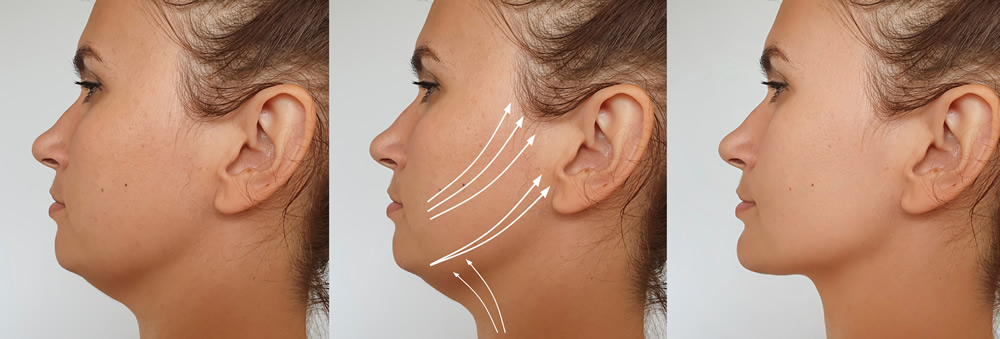
There is very little necessary to prepare for the treatment in terms of skin care – Dr. Green may ask that you do not wear make-up to the appointment as it will need to be washed off on arrival. The appointment will begin with cleaning your skin of any dirt of make-up that may still be found on your face. Then Dr. Green will apply the ultrasound gel and use the Ultherapy applicator to locate the treatment area using ultrasound imaging. Once the treatment area has been determined, the Ultherapy applicator will begin to emit pulses of heat energy in order to heat up the tissue and stimulate the body’s natural healing process. While the pulses of energy are being emitted, the patient may experience a tingling or slight amount of heat on the surface of the skin. This is normal for the procedure and does not mean that there is any damage being done on the surface of the skin.
The amount of time necessary to complete the treatment will vary from patient to patient, depending on the size and scope of the treatment area. Typically, the treatment process lasts an hour. For patients receiving treatment on their face or neck, the treatment lasts for about 60 to 90 minutes while those receiving treatment on the décolletage may have their procedure last only 30 minutes.
What is the aftercare following the Ultherapy procedure?
Ultherapy is a non-invasive procedure that requires no downtime following the treatment. This means that patients can return to their normal activities directly following the treatment procedure. Some patients experience mild side effects after then treatment including redness, swelling, tingling, or tenderness at the treatment site. These side effects are typically mild and will go away on their own within a couple of hours or several days. If patients do receive more intense side effects, such as bruising in the treatment area or numbness, it is best to contact your Ultherapy provider.
Most patients only require one Ultherapy treatment before they start to see results but some patients may need to return for a touch up. The results of Ultherapy treatment begin to show within two to three months after receiving the treatment as the natural healing process triggered by the procedure takes effect. The skin tightening effects of Ultherapy do not last forever so patients will need to return after approximately one year to receive the treatment again in order to maintain the results.
Comparing Ultherapy to Thermage
Both Thermage and Ultherapy devices work to stimulate collagen formation in the dermis to help tighten the facial features. Ultherapy, however, is only FDA approved for the face and décolletage areas, while Thermage is FDA approved for many parts of the body, including the face, neck, décolletage, eyelids, brows, periorbital region, arms, abdomen, thighs, buttocks, and above the knees. With greater FDA indications for Thermage, it is no wonder that Thermage treatment outnumber Ultherapy.
Thermage, including the Thermage FLX, is much more comfortable than Ultherapy. Most of our patients prefer Thermage since it is painless and highly effective. Both Thermage and Ultherapy treatments are performed once a year with the full cosmetic results visible in 4-6 months. Ultherapy can occasionally cause light bruising and can require more potential downtime. Ultherapy also requires pre-medication with strong pain medication and the patient should not return to work on the same day. Thermage, on the other hand, does not require any pain medicine or numbing cream and has absolutely no downtime.
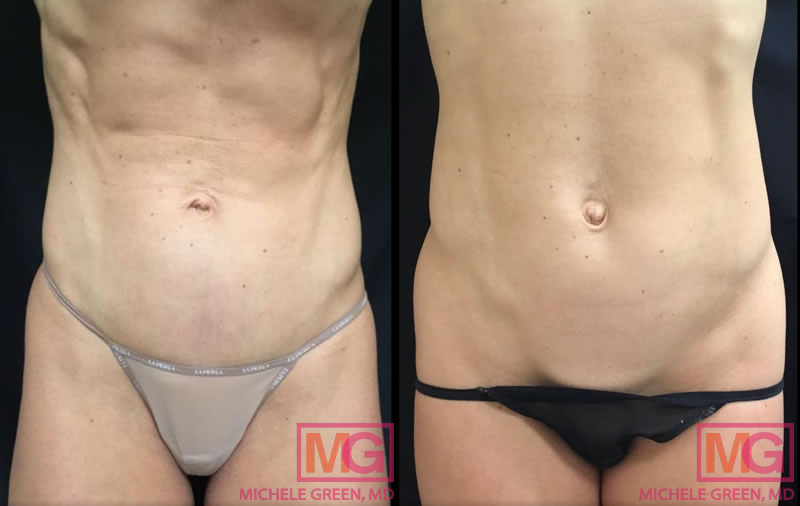
Thermage in abdomen area – 4 months
What is Thermage for skin tightening?
Thermage radiofrequency (RF) technology is often considered the gold standard treatment for tightening the skin and providing patients with a smooth, firm, and youthful look. While Ultherapy has been FDA-cleared to treat the face, neck, and décolletage, Thermage has been cleared to treat those areas of the body and well as the arms, hands, knees, buttocks, legs, and abdomen. Thermage applicators have different size tips in order to treat different areas of the body quickly and effectively.
Thermage RF treatment has a similar function to Ultherapy in that it works to tighten and contour the skin by stimulating the production of collagen in the body. By triggering the body’s own healing process for the increased production of collagen, Thermage provides a natural-looking lift to the area of the body that is being treated. Thermage treatment is a non-invasive, non-surgical option for providing a “lift” to practically any area of the body and is Dr. Green’s go-to treatment for skin tightening. Thermage is extremely safe and effective and can be used on all skin types safely.
How does Thermage work?
Like Ultherapy, Thermage treatment triggers the body’s natural healing process, which stimulates the production of collagen. When the body produces more collagen, the aging skin, which is sagging and loose, is replaced by smoother, firmer skin. This creates a more youthful look and can reduce the appearance of fine lines and wrinkles. Unlike Ultherapy, however, Thermage uses a different method to trigger the production of collagen. Ultherapy uses ultrasound imaging and ultrasound energy to heat the deep layers of tissue. Thermage, on the other hand, uses radiofrequency technology. The applicator releases the radiofrequency energy, which penetrates into the deeper layers of your skin without harming the outer layer of skin. The Thermage machine in fact cools the surface of the skin while it heats the inner tissue. It is the heating of the inner layer that creates targeted, controlled damage to the tissue, which triggers the body’s natural healing response. As a result, the effects of the treatment become more apparent as time goes on and the body produces more collagen. Furthermore, the heat causes the water molecules to separate from the fibrous proteins, which immediately causes the bands to contract, which tightens the skin immediately.
What is the procedure for Thermage treatment?
If you are experiencing increased skin laxity as a result of the natural aging process, board-certified dermatologist, Dr. Green, can be counted upon to help. You will start the treatment process by making a consultation appointment with Dr. Green to discuss your specific needs. When looking to address issues of loose and sagging skin anywhere on the body, Dr. Green typically recommends Thermage RF treatment. The treatment is simple and painless and provides excellent skin tightening results.
When you first arrive at Dr. Green’s office for the Thermage treatment, Dr. Green will begin by outlining a grid on the face or body to define the treatment area. For the treatment itself, Dr. Green employs the Thermage Total Tip 3.0, which is the most up-to-date device of its kind. The Thermage Total Tip 3.0 combines immediate results with a comfortable treatment process. Dr. Green will apply the Thermage applicator to the surface of the skin in order to release the radiofrequency energy into the deep tissues. Patients typically experience a slight heating of the skin where the applicator is being applied followed by a cooling sensation. Most patients report that the procedure itself is not painful and the sensations evoke very minimal discomfort.
The amount of time that the treatment takes depends upon the scope of the treatment area and where on the body you will be receiving treatment. On average, treatment can take between 60 and 90 minutes to complete. There is no downtime required after the treatment so patients can return to their regular activities immediately following the procedure.
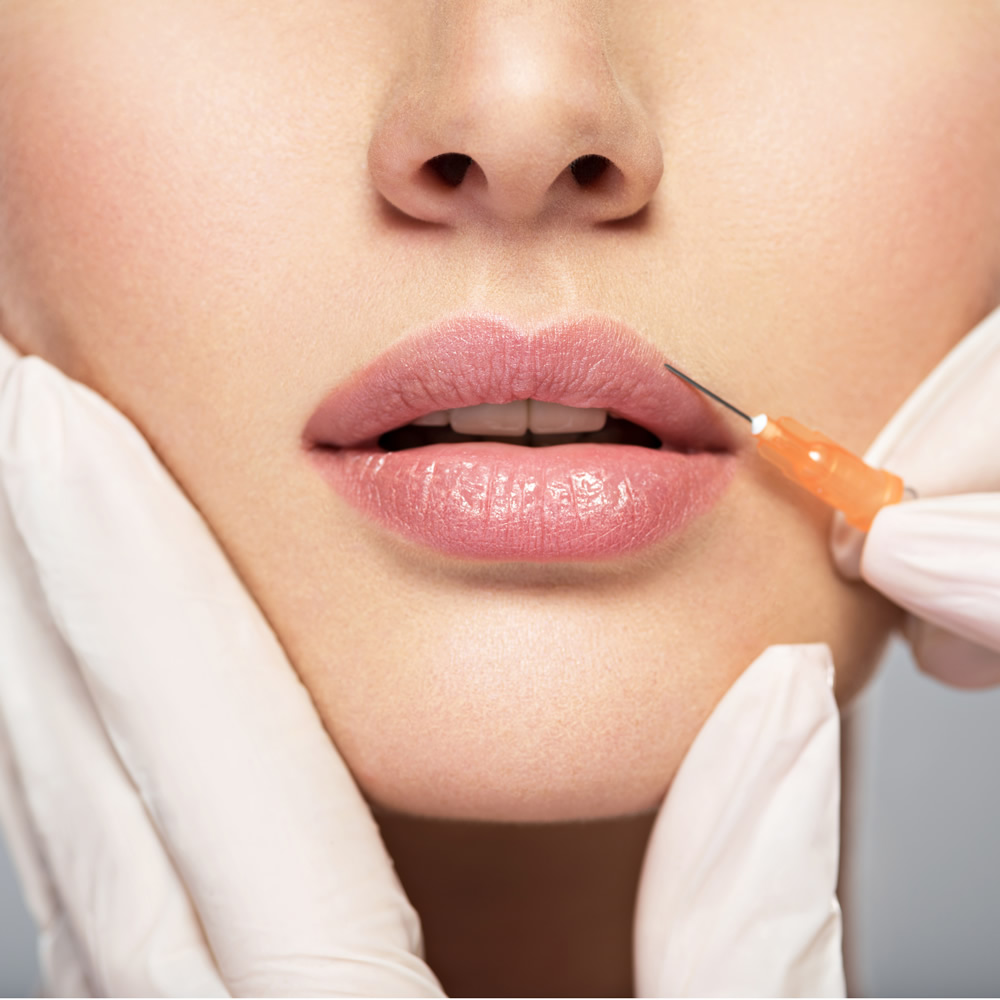
What is the aftercare for Thermage treatment?
Thermage, similarly to Ultherapy, is a non-invasive, non-surgical procedure for skin tightening and, as such, there is no recovery time necessary following the treatment. Following the treatment, patients may experience a “glow” on their skin or a slight swelling, but these effects provide minimal discomfort and resolve themselves on their own. There are no serious side effects for Thermage treatment and any redness on the surface of the skin following the procedure will dissipate after several hours.
In terms of skincare following the treatment, Dr. Green recommends carefully protecting your skin from the sun. To do so, you should wear sunscreen whenever you go outside or practice sun avoidance, meaning stay inside between the hours of 10am and 2pm when the sun is at its most intense. Sun damage to the skin can accelerate the signs of aging and for that reason, it is important protect your skin from the sun.
Which treatment is better for skin tightening: Ultherapy or Thermage?
Ultherapy and Thermage are often compared because they serve a very similar function and work in similar ways: both treatment options are best suited for tightening the skin and reducing the appearance of fine lines and wrinkles for a smoother, more youthful look. Both treatments are also similar in that they stimulate the production of collagen by triggering the body’s natural healing process in the fibrous tissues of the inner layer of skin. As a result, both procedures create a very natural look to treated area, providing you with subtle but very effective improvements. Both treatment options are also non-invasive, meaning there is minimal downtime or recovery time required. They are both a good option for patients who are looking to make a change but are not willing to undergo surgery.
They do differ, however in several key ways: for one, the method by which they cause the tissue to heat up is different between the two treatments. Ultherapy uses ultrasound technology to identify the treatment area and send energy to deep layers of skin. Thermage, on the other hand, uses radiofrequency energy to just as effectively heat the inner layer of the skin while still protecting the outer layer of skin. Further, Ultherapy has only been cleared to treat the face, neck, and upper chest area for skin tightening. Meanwhile Thermage has been cleared to treat almost any area of the body, including the face, neck, chest, arms, hands, legs, buttocks, and abdomen.
As Thermage is extremely safe and effective for use on all skin types and on all parts of the body. For that reason, Dr. Green considers Thermage the gold standard skin tightening treatment. While both treatment options are available at her office, Dr. Green believes in recommending the highest quality treatment to her patients and, for that reason, will frequently recommend Thermage skin tightening over Ultherapy.
Does Ultherapy Work on Jowls?
Ultherapy is touted as a strong option for those with mild skin laxity along the jawline, reducing the appearance of jowls. However, Dr. Green recommends combination treatments as an excellent way to improve the appearance of the neck, jawline, and double chin to create a youthful appearance. In her interview with Haute Living, Dr. Green reveals: “The ‘trifecta’ that I use for the aging neck in my practice is a combination of Thermage to tighten the neck, Botox injections for the wrinkles or cords of the neck, and CoolSculpting® or Kybella® if there is any submental fat under the chin. This combination produces a beautiful long-lasting result in treating the aging neck.”
Does Ultherapy work on neck?
Ultherapy treatment has been FDA cleared to help with skin tightening on three areas of the body: the face, the neck, and the décolletage (or upper chest). For that reason, Ultherapy is a good option for use on the neck. Ultherapy can be used to help eliminate what is frequently called “turkey neck.” Turkey neck is an unflattering term for the loose skin that forms along the neck as a result of the natural aging process. As we age, the body produces less collagen and elastin, meaning our skin will become more and more lax. Ultherapy, or alternate skin tightening treatments such as Thermage, work to increase collagen production in the neck and therefore eliminate the loose skin that forms so-called “turkey neck.”
How painful is Ultherapy?
Many patients are nervous about non-invasive skin tightening and wonder, does Ultherapy hurt? For most patients, there is slight discomfort from Ultherapy treatment, often described as a tingling or burning sensation. In order to reduce this sensation, patients can be treated with a local anesthetic, sedative, or pain medication. There are very few side effects associated with the treatment and all of them are mild. Some patients experience redness, swelling, or tingling at the treatment area but these symptoms dissipate quickly following treatment. As such, there is very limited pain or discomfort associated with the treatment.
Is Ultherapy Safe?
Ultherapy was FDA-approved for skin tightening treatment on the midface, lower face, neck, and décolletage and for non-invasive eye brow lift after demonstrating safety in clinical studies. It’s designed to safely lift skin and reduce skin laxity, particularly along the jawline. The treatment is popular all over the world and since its clearance in 2009, the Ultherapy treatment has been performed approximately 1.5 million times.
Can Ultherapy go wrong?
Ultherapy is a non-invasive medical procedure and for that reason, the risk of any significant side effects is very low. While thousands of procedures have been safely performed since the treatment was cleared by the FDA in 2009, like any procedure, there is always a risk of greater harm. This risk can be avoided if you book your appointment with an expert, board-certified dermatologist, such as Dr. Green. You are much less likely to experience adverse side effects when the procedure is being performed by a very experienced practitioner like Dr. Green.
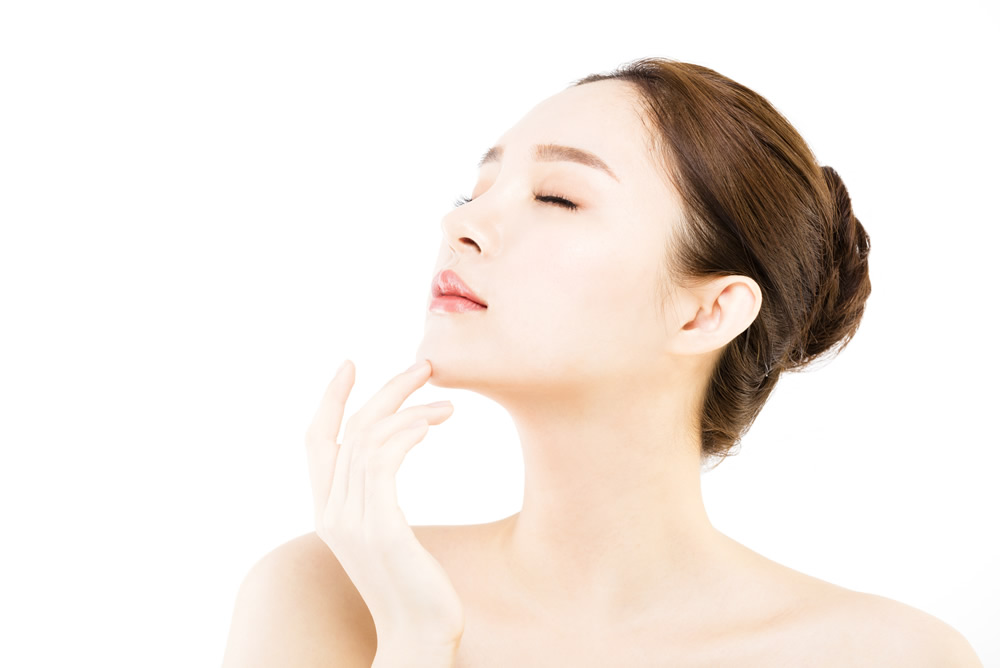
Are There Any Side Effects to Ultherapy?
When it comes to side effects, these are generally fairly minimal with Ultherapy. The most common side effects reported in clinical trials were redness and soreness. In some cases, bruises or numbness may occur, but this is somewhat uncommon. In most cases, side effects dissipate quickly, with redness and soreness only causing discomfort for, at most, a couple of hours.
How Much Does Ultherapy Cost?
When patients ask, how much is Ultherapy, the answer is: it depends. There are several factors that determine the cost of treatment including the size and scope of the treatment area, the institution at which you are receiving treatment, and your geographic location. Generally speaking, the more area you are having treated, the more expensive your treatment is going to be. Further, the laxity of your skin can have an effect on how intensive the treatment needs to be, which can also adjust the price. The cost of Ultherapy may be less expensive at an institution like a MedSpa, however, the risk of adverse side effects increases if you opt to have treatment at the hands of a non-board-certified practitioner. While the price of treatment increases, it is safer to receive treatment from an expert board-certified dermatologist, such as Dr. Green.
When it comes to a full face treatment, Ultherapy frequently hovers around $4,000-$5,500, which is at the higher end of the spectrum of skin tightening treatments. Alternatively, Thermage is generally more affordable, and ranges more widely depending on the size and skin condition of the area being treated, varying from around $3,500-$4,500.
How Much is Ultherapy for Neck Tightening?
The cost for Ultherapy neck tightening varies depending on the skin condition and size of the region being treated. However, the cost of Ultherapy for the jawline and neck ranges from $4,000-$5,500 for treatment from experienced dermatologists.
How Long Does Ultherapy Last?
Ultherapy does have long-lasting results for many patients, with skin tightening benefits that can last up to two years after initial treatment. However, most patients engage with annual follow-up treatments in order to keep pace with the aging process and create new collagen. The Ultherapy treatment can be repeated approximately once a year in order to maintain the youthful-looking results of the treatment.
Is Ultherapy Worth It?
Ultherapy can be an effective nonsurgical skin tightening procedure for patients with mild skin laxity in the face, neck, or décolletage. However, one of the downsides of ultrasound technology (and other procedures that rely solely on collagen production) is that the collagen-building process takes time. So for those looking for instant results, Ultherapy may not be suitable, as the best results from the procedure are achieved over time, and can take up to a few months after the last treatment. The procedure is also painful and requires pre-medication with analgesics. The good news, however, is that Ultherapy is long lasting, with the results from the treatment lasting up to two years, depending on the individual.
Other Cosmetic Procedures
Thermage is a similar highly effective FDA approved laser treatment for skin tightening and rejuvenation and is a fabulous option that Dr. Green recommends as a non-invasive skin tightening procedure. With no discomfort, no recovery time, and even better skin tightening results, the new Thermage FLX has been a favorite treatment in Dr. Green’s NYC office since its release.
For those individuals who are looking for faster results, procedures such as Botox Treatments and other Dermal Fillers may be an option, too. All of these injectables are great at combating and reducing the effects of the natural aging process. Additionally, combination treatments with dermal fillers, Botox, Microneedling, Fraxel laser, CoolSculpting, and skin tightening procedures can be used for pan-facial rejuvenation and body contouring.
Botox injections
Onabotulinum toxin type A, more commonly known by its brand name Botox, is an extremely popular injectable treatment to reverse signs of the natural aging process. Botox is FDA approved to treat fine lines and wrinkles that appear on the face in order to create a smoother, more youthful look. When Botox is injected into the treatment area, the neurotoxin in the injection blocks the neurotransmitters that give the signal to muscles to contract. As a result, the Botox “freezes” the muscle, which helps to eliminate and prevent dynamic wrinkles. Botox is very effective to use in conjunction with skin tighteners, such as Ultherapy and Thermage.
Dermal Fillers for collagen replacement
Dermal fillers are also extremely effective at reversing signs of the natural aging process by replacing volume lost by the decline of collagen production. While Thermage and Ultherapy tighten the skin, they do not have the ability to add volume to the face, which is where dermal fillers come in. The treatment works by injecting the hyaluronic filler into the treatment area (most commonly under the eyes, in the midface, and lips) to restore volume and moisture to the skin.
Microneedling to produce new collagen
Microneedling is another anti-aging treatment that helps to stimulate the production of collagen for firmer, smoother skin. The procedure involves the application of a Microneedling machine, which creates micro-wounds along the surface of the skin. The creation of micro-wounds triggers the body’s natural healing process, which then stimulates the production of collagen. Microneedling can also be used in conjunction with Ultherapy and Thermage.
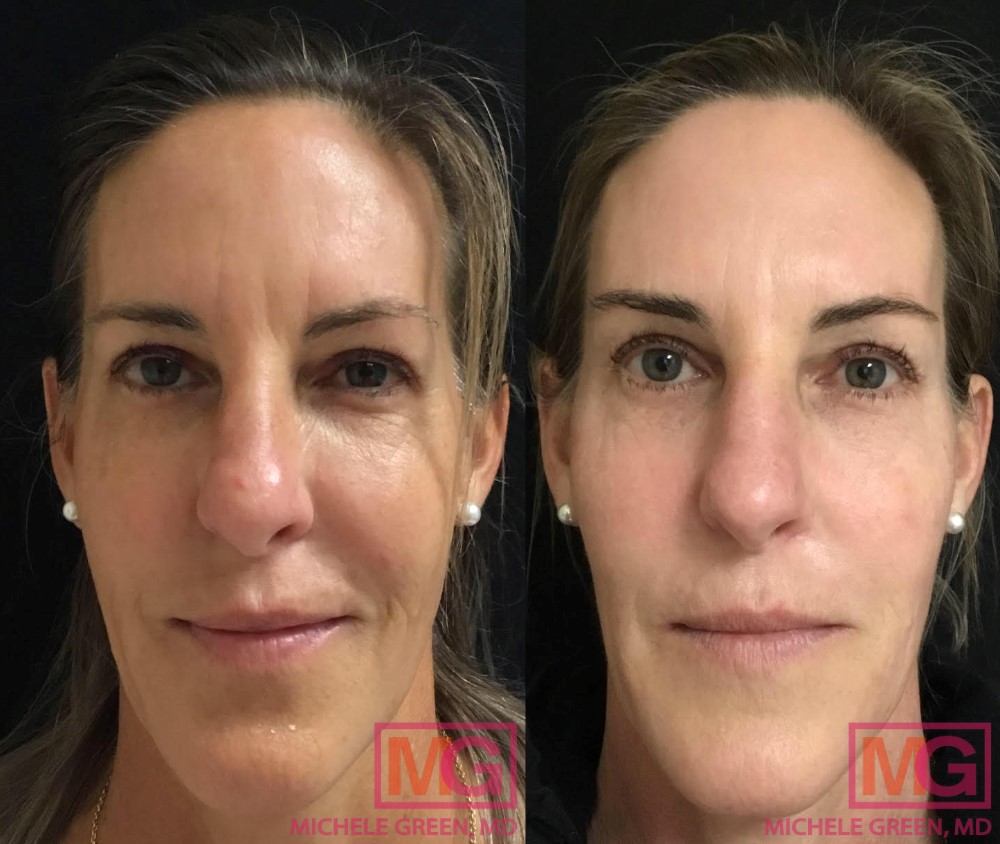
Fraxel & Botox – 2 sessions
Fraxel Lasers
The Fraxel Dual Laser is a non-ablative skin resurfacing laser, often referred to as the “magic eraser” that utilizes fractionated laser technology to treat a myriad of skin concerns. The Fraxel emits wavelengths of light in a precise and controlled manner to create micro-injuries on the surface of the skin. Fraxel can be used to address an array of concerns including fine lines, wrinkles, unwanted hyperpigmentation, sun damage, and acne scars, among others. When the Fraxel laser produces micro-injuries on the surface of the skin, it triggers the body’s natural wound healing process. As a part of the healing process, new collagen and elastin production is stimulated. The result of having treatment with Fraxel is a smooth, healthy, and youthful complexion.
CoolSculpting
CoolSculpting treatment is effective in freezing fat cells to reduce bulges of fat on various parts of the body including the stomach, legs, and arms. CoolSculpting is often paired with a skin tightening treatment like Ultherapy or Thermage. This is the case because when CoolSculpting removes the pocket of fat from the treatment area, patients are frequently left with very loose, lax skin. For that reason, Ultherapy or Thermage is employed to tighten the skin in the treatment area.
Ultherapy & Non-Surgical Facelifts in NYC
The next step in deciding whether you make a good candidate for a skin tightening laser is to schedule a consultation with Dr. Michele Green in her private New York City office. After an extensive consultation, she will help you determine the best treatment plan for you. From Botox, Juvederm, Fraxel, Thermage and CoolSculpting, to Kybella and Ultherapy, all of these procedures have a proven track record of safety and producing outstanding cosmetic results. If you are dealing with skin laxity, around the face, jawline, or body, there’s finally a solution that can help. Contact us online today or call 212-535-3088 at our New York City private office to learn more about which non-invasive skin tightening treatments will be best for you.
 212-535-3088
212-535-3088